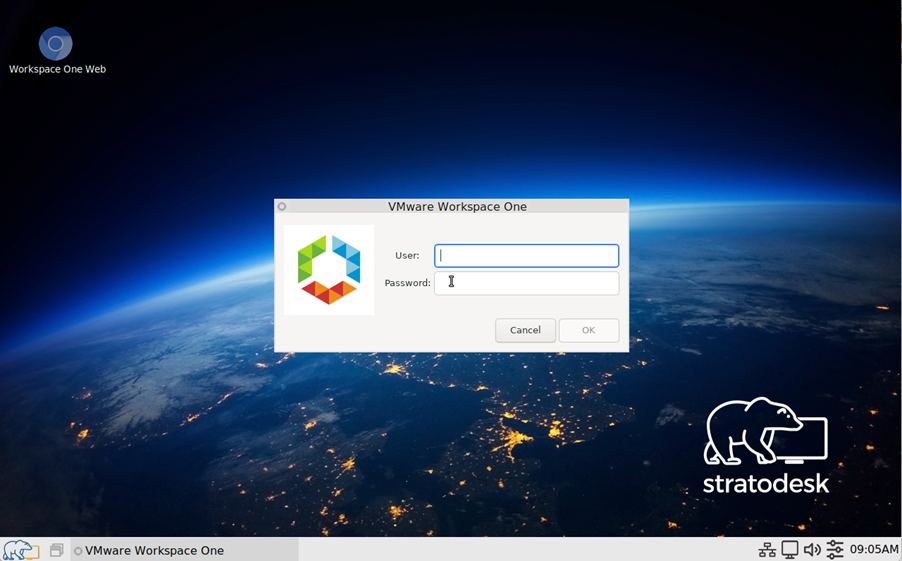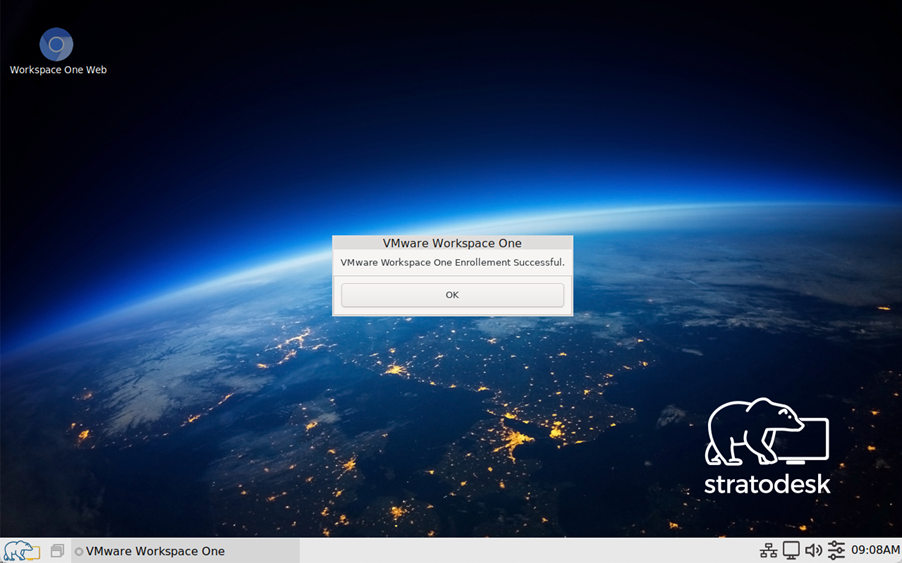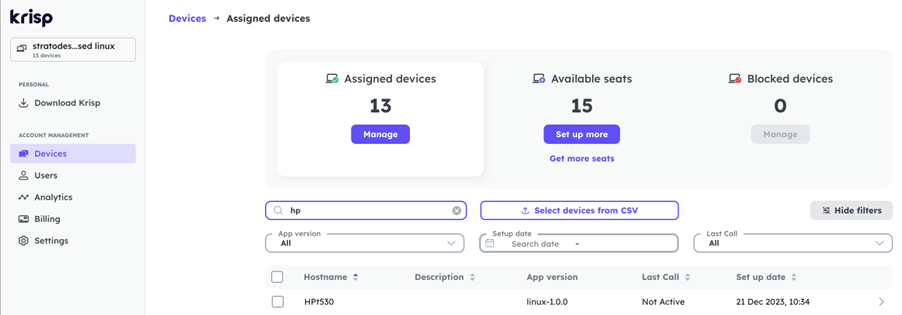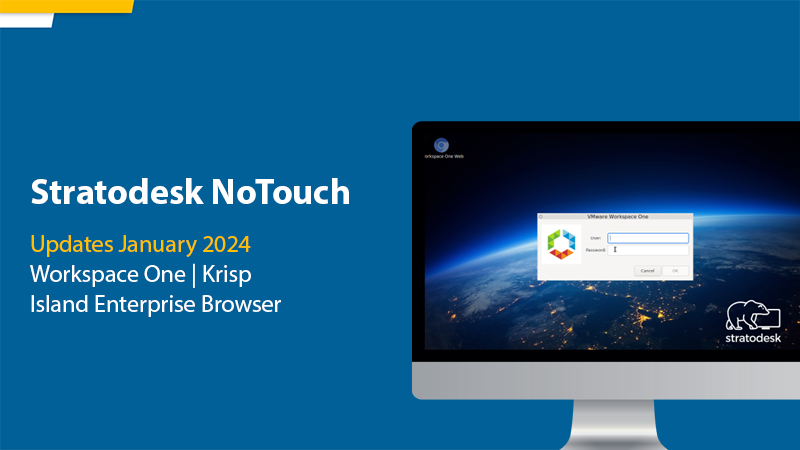To start the New Year on a high note, I wanted to share an exciting blog that delves into the latest and most innovative features of Stratodesk NoTouch.
We are thrilled to announce the launch of NoTouch OS firmware version 3.5.298 as GA, and we can’t wait to share with you some of the exciting new features showcased in the blog below.
Workspace One
The first is support for Workspace One from VMware, or Broadcom as they’re now known. Firstly, to take advantage of this feature, you need to be using one of our EEws rather than EEs images. If you want to know more about the naming of our images, then feel free to read the previous blog on NoTouch OS Build Taxonomy. You’ll also need to be running NoTouch Center version 4.5.501.
Workspace One is VMware’s (Broadcom) own MDM solution, and our integration allows NoTouch OS endpoints to register with the management platform which in turn can distribute a configuration including certificates, and configuration access policies. What it won’t do is deploy connection configuration to the endpoints, this is still done by NoTouch Center.
Configuration of the endpoint is also very simple, and I’ve highlighted these below. Unless you’re using a service account, it’s better to leave the Workspace One user ID and password blank.
 After successfully configuring the device, notify the endpoint of the changes and initiate a device reboot. Once the reboot is complete, the user will be prompted to enroll the device by entering their username and password.
After successfully configuring the device, notify the endpoint of the changes and initiate a device reboot. Once the reboot is complete, the user will be prompted to enroll the device by entering their username and password.
 After successfully logging in, users will receive a notification on their screen confirming the successful enrollment to Workspace One.
After successfully logging in, users will receive a notification on their screen confirming the successful enrollment to Workspace One.

Now the user will be able to log into the environment, and access resources based on policies created by Workspace One parameters which will include access to the Horizon desktop environment.
Note: After the device has undergone a reboot, all policy configurations will be reset, requiring the user to log in again for enrollment.
Krisp
The next update relates to technology from a company called Krisp who provide audio background and voice cancellation technology that detects and removes all other nearby human voices and allows only the primary speaker’s voice to pass through the call. This is an ideal solution not just for enterprises and call centers, but even for remote workers who might need to limit background noise. You can find further information on their website.
The Krisp software is not included in our images by default, so you’ll need to download the Debian package from their website and deploy this to your NoTouch OS endpoints using the Extension module feature. In addition to this, you’ll need to configure the following parameters in the ‘Services’ group settings as shown below.

You’ll then need to announce the change and reboot the endpoint. If everything has been configured correctly, then the device should have registered correctly in the Krisp portal.

Devices that are connected to the Krisp portal will then start to report call and noise cancellation statistics that can then be reviewed in the Analytics area of their portal.
Island Enterprise Browser
The final new update relates to Island Enterprise Browser, which provides administrators with complete control over the browser, so is ideal in zero trust, SaaS, VDI, and BYOD environments but these are only a few of its many use cases.
Island Browser is deployed using the Extension module built into NoTouch Center.

Finally, push the new Island Browser connection to the endpoint, and then reboot the device to complete the installation.
After launching the browser, users will need to log in with their unique username and password before gaining access to browse the internet or other valuable resources.
Once the user has been authenticated access is controlled via policies that are defined in the Island management console which have been set by the administration team which restrict and monitor the users’ sessions.
When organizations are seeking to regain control, enhance visibility, and strengthen the security of their endpoints, the addition of Island Enterprise Browser to the Stratodesk solution stack proves to be an excellent choice.
Raspberry Pi 5 and Arm64
This release also brings support for the Raspberry Pi 5 and support for Arm64-based images. The new Arm64 image will run on both the Raspberry Pi 4 and 5. However, before updating to the Arm64 image, those using the older Pi 4 please be aware that there are currently some limitations in terms of VDI client support, and this is not a Stratodesk limitation. Below is a list of what is currently supported.
- Citrix Workspace App
- FreeRDP
- Chromium
- Firefox
We will look to add additional VDI client support as and when or if they become supported by the vendors.
If you do have a Pi 4 that is running an ARMHF build and you want to update this to the Arm64 version then this is possible, but please be aware of the limitations. Please also note the Pi 5 devices cannot run an ARMHF version of NoTouch OS due to a difference in hardware architecture.
Here’s a comprehensive overview of the latest additions, enhancements, fixes, and security updates available in the summary below.
New Features
- Add support for loading the Krisp browser plugin
- VMware Workspace ONE support (EEws image)
- Raspberry 5 support [Raspberry Pi]
- 64-bit ARM (arm64 support) [Raspberry Pi] (EXPERIMENTAL)
- Support for sideloading the Island enterprise browser (EXPERIMENTAL)
Updates
- Citrix: Update Citrix Workspace App to 2311 (23.11.0.82)
- VMware Horizon: Update VMware Horizon View client to 2309-8.11.0-22660930
- Update Raspberry Pi firmware/kernel to 3d5ffbf469 (6.1.65) [Raspberry Pi]
- Parallels RAS: Update Parallels RAS client to 19.3 (24619) [x64, PC (x86/x64)]
- Chromium: Update Chromium, use the newer upstream repo
Improvements
- Azure Virtual Desktop (AVD): Update AVD base layer
- Azure Virtual Desktop (AVD): Audio WebRTC Browser Tab Redirection (EXPERIMENTAL)
- Azure Virtual Desktop (AVD): RDP ShortPath on public networks
- Citrix: Fido2 in Citrix AuthManager defaults to off
- Update Python to 3.11
- Update hplip, lldpd, snmpd, vim, perl
- Support analog mic on ESSX8336
- Speed up support file creation
- VMware Horizon: Add a new parameter for all sessions disconnected behavior
- VMware Horizon: Add new parameter for preferred webcam name (next to already existing ID param)
- Update Bluetooth stack
- Shrink support file size when BeyondTrust RS is used
Fixed Issues
- VMware Horizon: Fix an issue with scanner redirection
- Citrix: Fix window size parameters
- Imprivata: Fix Prove ID Embedded shell crashing issue
- Fix timezone issue with old US zones
- Azure Virtual Desktop (AVD): Fix the inability to preconfigure an AVD resource to launch
- Security Updates
- Recompile Dropbear SSH without chacha20-poly1305 and with Strict-KEX (Terrapin/CVE-2023-48795)
That’s a roundup of some of the new features of NoTouch OS this month! Don’t miss out on any updates by subscribing to our newsletter and following us on Twitter or LinkedIn.

